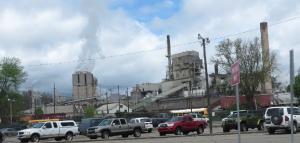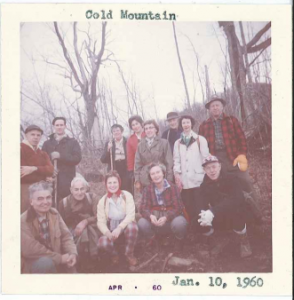This preservation story begins with this victorious newspaper headline:
The Asheville newspaper clipping proclaimed Shining Rock as part of the Pisgah National Forest now to be protected by the U.S. Government. Before the Asheville Citizen picked up the news story, the National Forest Service produced this document that designated land “20 miles southwest of Asheville” to become a nationally protected wilderness area. The tract is now known as the Shining Rock Wilderness. It is located in Haywood county in Western North Carolina and is situated near the Blue Ridge Parkway. Shining Rock’s environmental integrity was challenged by commercialists looking to expand roadways throughout the area, most notably an expansion of the Blue Ridge Parkway. Commercialization in this area threatens many valuable natural resources. In order to protect the flora and fauna, and also the land itself, the National Forest Service declared the 13,400 acres true wilderness.
How does someone create a nationally recognized wilderness? The answer is simple: written formal complaints to local bureaucrats. The Carolina Mountain Club wrote a petition to Peter J. Hanlon. In their petition they demand that Shining Rock be preserved for its natural beauty. The CMC wrote Peter J. Hanlon who was the supervisor in North Carolina for the National Forest Service. He had the responsibility of protecting one of the largest conservation areas in the United States (Linville Gorge, NC), yet Hanlon was still able to hear his constituents’ concerns. After reading this letter, he functioned as the liaison between the Carolina Mountain Club and the National Forest Service. On the CMC’s behalf, Hanlon worked to guarantee the preservation of this tract. Without Hanlon, there would be no Shining Rock Wilderness. After Shining Rock became wilderness, it and Linville Gorge boasted 80 percent of the protected lands east of the Mississippi.1)
Instead of 13,400 acres of untouched wilderness, imagine what this resource rich area might have become:
Pictured above is the Blue Ridge Paper Company in East Canton a mere 5 miles from Shining Rock. Besides producing a putrid chemical smell, this industry makes a living from chopping down trees. Firstly, where does a paper plant dump their industrial waste? Secondly, does this plant, or any other paper company operate using sustainability practices? Perhaps the Carolina Mountain Club saved the area closest to Shining Rock from a similar industrialized fate.
Not pictured on this site is the enormous country club complex in even closer proximity than Blue Ridge Paper. The golf course and the attached condominiums complex was impossible to miss on the drive to a Shining Rock trailhead. Considering all types of commercialization, a country club and golf resort are among the least beneficial to conservation efforts. A dogleg par-4 does not match the beauty found in subtle river-bend. While the Carolina Mountain Club mission is enjoying outdoors through leisure and sport, Western North Carolina’s natural beauty is certainly invaded by sand traps and the perpetual “Fore!”
You too can foster positive change by contacting local officials. For the Carolina Mountain Club, they wrote to the the Supervisor of North Carolina National Forests simply petitioning land use. The Club did not want to see Shining Rock fall victim to the same industrialization or commercialization that impedes and obstructs the natural beauty in Western North Carolina. The easiest way to protect our sacred land is by contacting our local politicians. They work at the ground level and are paid to hear our concerns. Change does not happen over night. Change takes initial agency and persistence to see it through. These Carolina Mountain Club members pictured below could not have possibly known that within 4 years of this picture, Cold Mountain would be included in one of the largest wilderness areas east of the Mississippi. In fact, the Carolina Mountain Club could use your help today. Conservation efforts are ongoing. To learn ways you can become involved with current conservation, visit the CMC’s Conservation Committee page.
Even increased awareness and knowledge of the surrounding area is a start to conservation. Click the image to play a game illustrating the natural resources including plants and animals unique to Shining Rock and Western North Carolina:
References
| ↑1 | Newfont, Kathryn, Blue Ridge Commons: Environmental Activism and Forest History in Western North Carolina. Athens, GA: University of Georgia Press, 2012. |
|---|


